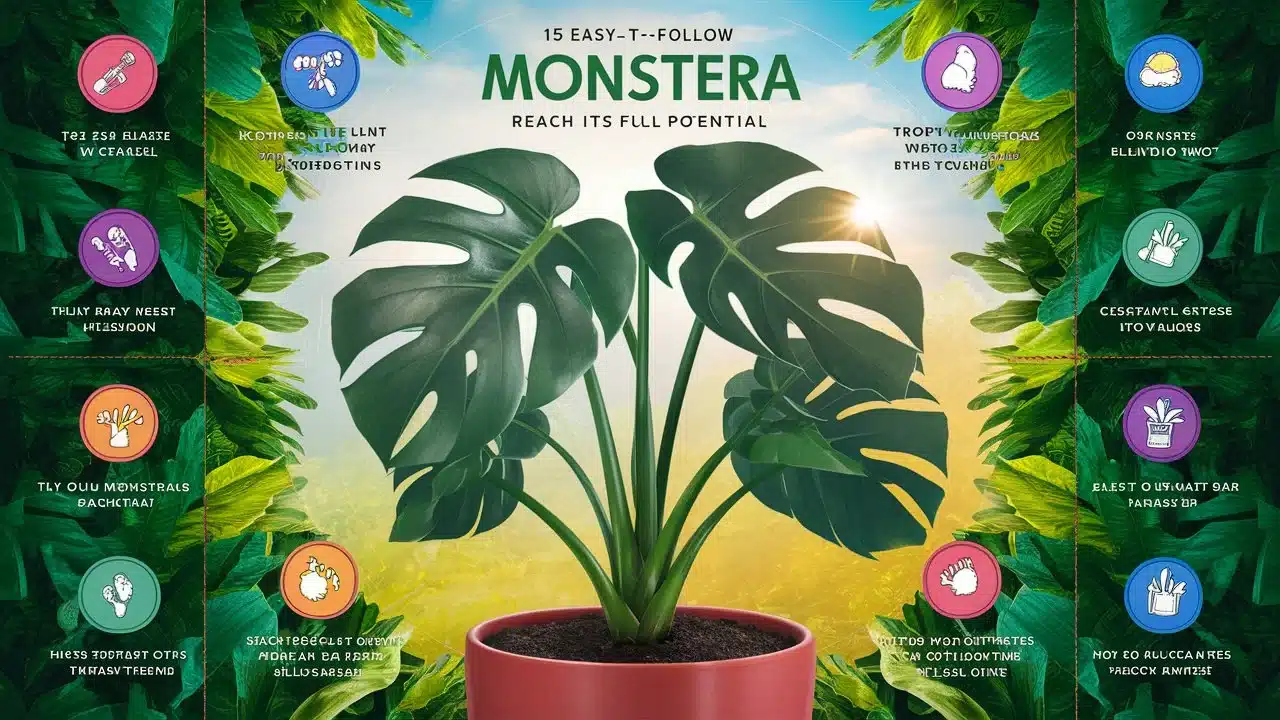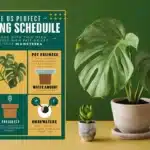Monstera plants are known for their striking leaves and easy-going nature, making them a favorite among plant lovers. But to truly unlock your Monstera’s full potential, you need to provide the right care. From optimizing light conditions to ensuring proper humidity and pruning techniques, every small action adds up to help your Monstera thrive.
In this guide, we’ll dive deep into 15 easy ways to unlock your Monstera’s full potential, providing practical tips based on proven techniques and expert knowledge.
Optimizing Light Conditions

Light is one of the most important factors in a Monstera’s growth. Native to tropical forests, Monsteras thrive in bright, indirect light—this mimics the dappled sunlight filtering through jungle canopies.
Why Bright, Indirect Light is Key
Monsteras need ample light to develop their characteristic fenestrated leaves. If your plant isn’t receiving enough light, it may grow smaller leaves, or worse, none at all. Too much direct light can cause sunburn, leading to brown, crispy patches on the leaves.
Pro Tip: Place your Monstera near an east-facing window for morning sunlight, or a few feet back from a south or west-facing window.
Balancing Light
It’s crucial to strike a balance. If you notice leggy growth—where the plant stretches toward the light—it might be time to move it to a brighter spot.
Light Table:
| Window Direction | Light Type | Best Placement |
| East | Bright, indirect | Close to window |
| South | Bright, indirect | 3-5 feet away |
| West | Bright, indirect | 3-5 feet away |
Using Grow Lights
If you live in a darker environment or have limited natural light, consider using grow lights. LED grow lights with full-spectrum wavelengths can supplement sunlight, especially in winter.
Boosting Humidity

Monsteras hail from humid tropical environments, so they thrive in conditions with 60%-80% humidity. Creating a humidity-rich environment is vital for your Monstera’s health.
Why Humidity Matters
Dry air can cause leaf browning and slow down growth. To prevent this, boost the humidity in your home, especially in winter when indoor heating tends to dry out the air.
Ways to Boost Humidity
- Use a Humidifier: A small, inexpensive humidifier can increase the moisture around your plant.
- Mist Your Plant: Mist the leaves occasionally to mimic natural moisture levels.
- Group Your Plants: Place multiple plants together to create a small microclimate.
- Pebble Tray: Put your Monstera’s pot on a tray filled with pebbles and water. As the water evaporates, it will increase the humidity around the plant.
Fact: Monsteras need more humidity than many other houseplants, so don’t ignore this factor if you want lush growth.
Soil Quality & Composition
The right soil is the foundation for a healthy Monstera. These plants need a well-draining, aerated soil mix to ensure their roots don’t sit in water, which can lead to root rot.
Best Potting Mix for Monsteras
Monsteras do best in a chunky soil mix. Here’s a simple recipe for a perfect Monstera potting mix:
- 40% Coco Coir or Peat Moss (retains moisture)
- 20% Perlite (provides aeration)
- 20% Orchid Bark (creates chunkiness)
- 20% Compost or Worm Castings (adds nutrients)
Why Compacted Soil is a Problem

Over time, soil can become compacted, squeezing out the air pockets that roots need. Regularly refreshing the top layer of soil or repotting every year can help maintain soil structure.
Pruning for Better Growth
Pruning isn’t just about shaping your Monstera—it’s about encouraging new growth and keeping the plant healthy. Strategic pruning helps eliminate old or damaged leaves and promotes stronger growth.
How to Prune Monsteras
- Remove yellow or dead leaves: These are often a drain on the plant’s energy.
- Trim aerial roots: If you’re not using a moss pole, trimming the long, stringy roots can tidy up the plant without harming it.
- Make strategic cuts: To encourage branching, cut just above a leaf node, where new growth will sprout.
Pruning also gives you an opportunity to inspect your Monstera for pests or diseases.
Fertilization Routine
Fertilization is critical for unlocking your Monstera’s full potential, especially during the growing season. Using a balanced fertilizer helps to promote lush foliage and healthy roots.
Understanding N-P-K Ratios
Fertilizers are typically labeled with N-P-K ratios:
- N (Nitrogen): Encourages healthy leaf growth.
- P (Phosphorus): Supports root development and blooming.
- K (Potassium): Strengthens the plant’s overall health.
A 20-20-20 fertilizer is ideal during the growing months (spring and summer). However, reduce feeding in fall and winter when the plant enters its dormancy phase.
How Often to Fertilize
During the active growing period, fertilize your Monstera every 4-6 weeks. Watch for signs of overfeeding, like yellowing leaves, which indicate nutrient burn.
Epsom Salt: Myth or Magic?

There’s a lot of buzz around using Epsom salt for plants, but does it really help? The answer: Yes, in moderation.
Benefits of Epsom Salt
Epsom salt is a source of magnesium and sulfur, both essential nutrients for plant growth. Magnesium helps with chlorophyll production, while sulfur aids in enzyme function.
How to Use Epsom Salt Safely
- Dissolve 1 tablespoon of Epsom salt in 1 gallon of water.
- Apply the solution once a month during the growing season.
- Avoid overuse—too much can lead to a buildup of salts in the soil, causing harm to the plant.
Tip: Always monitor your Monstera’s health after applying Epsom salt. If you see any signs of distress, scale back on the application.
Watering Techniques

Overwatering is one of the most common mistakes with Monsteras. To unlock your Monstera’s full potential, learning the right watering techniques is essential.
How to Water Your Monstera
- Water deeply: Water until it runs out of the drainage holes.
- Let the top inch of soil dry out before watering again.
- Avoid overwatering: Excess water can lead to root rot, one of the main killers of houseplants.
Use a Moisture Meter
To avoid guesswork, use a moisture meter. Insert it into the soil and only water when the meter reads dry at the root level.
Cleaning and Shining Leaves
Keeping your Monstera’s leaves clean is more than just for appearance—it’s essential for photosynthesis.
Safe Methods for Cleaning
- Wipe with a damp cloth: Use a soft cloth dipped in water to gently clean the dust off the leaves.
- Avoid harsh chemicals: Stick to water or natural solutions like diluted neem oil.
Fact: Dust blocks light from reaching the leaves, reducing the plant’s ability to photosynthesize efficiently.
Supporting Growth with Moss Poles
Monsteras are natural climbers. Supporting your plant with a moss pole encourages vertical growth and mimics their natural environment.
How to Use a Moss Pole
- Place the moss pole in the center of the pot.
- Gently secure the Monstera’s aerial roots to the pole with ties.
- Keep the pole moist—Monsteras love climbing on damp surfaces.
Pest Control
Like most houseplants, Monsteras are prone to pests like spider mites, mealybugs, and thrips. Proper pest control is crucial for healthy growth.
Common Pests and Treatments
- Spider Mites: Use neem oil or insecticidal soap.
- Mealybugs: Wipe with alcohol-soaked cotton swabs.
- Thrips: Use sticky traps and neem oil.
Regularly inspecting your Monstera for pests will help catch infestations early.
Repotting: When and How
Monsteras can outgrow their pots quickly. Knowing when to repot is essential for keeping your plant healthy.
Signs It’s Time to Repot
- Roots growing out of drainage holes.
- Soil dries out too quickly after watering.
- Plant appears root-bound, with tangled roots circling inside the pot.
Tip: Always go up one size when repotting to give the roots space to expand without overwhelming the plant.
Proper Air Circulation
Stagnant air can lead to fungal problems and slow growth. Ensuring your Monstera has proper air circulation helps keep the environment fresh.
Ways to Improve Airflow
- Use a fan to gently move the air around the plant.
- Avoid cramping: Don’t place your plant in a stuffy, enclosed space.
Avoiding Temperature Extremes
Monsteras thrive in temperatures between 65°F and 85°F. Extremes—whether too hot or too cold—can damage your plant.
Cold Damage
Monsteras are sensitive to cold drafts, so keep them away from windows or doors that may let in chilly air. Symptoms of cold damage include wilting and blackened leaves.
Heat Stress
On the other hand, extreme heat can cause leaves to curl or droop. Ensure your Monstera isn’t sitting too close to a heater or in direct sunlight.
Case Study: Dramatic Monstera Growth with Correct Care
A plant enthusiast, Maria, shared her journey of reviving a leggy Monstera. After implementing the right techniques—adding a moss pole, increasing humidity, and adjusting light—her Monstera went from limp to lush in just six months.
Here’s what she did:
- Moved to a brighter spot near an east-facing window.
- Added a moss pole to support vertical growth.
- Increased the humidity using a humidifier.
The results were striking: new leaves sprouted every month, and the plant developed the iconic split leaves it had been missing.
Conclusion
Unlocking your Monstera’s full potential is all about providing the right care in the right environment. From optimizing light conditions to enhancing humidity and using correct pruning techniques, small actions make a huge difference. Follow these 15 easy ways to ensure your Monstera grows lush, healthy, and full of character. Happy planting!









